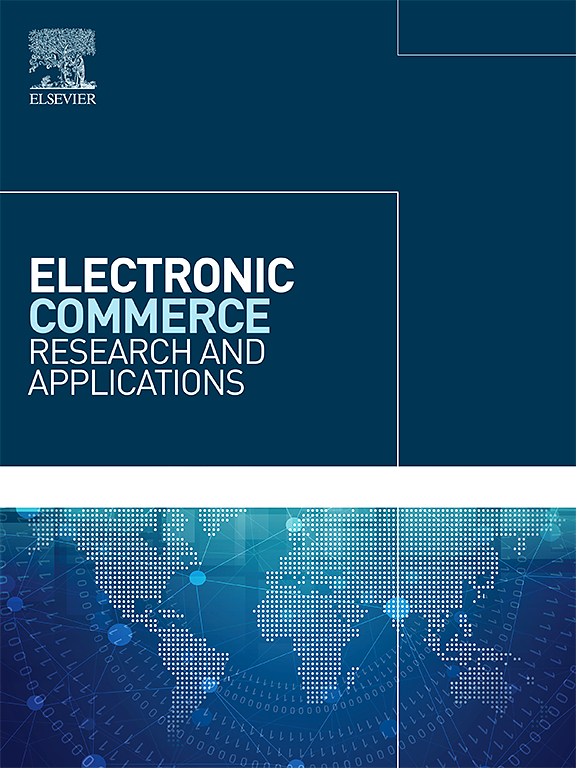考虑随机购买概率的基于收益的个性化产品推荐
IF 5.9
3区 管理学
Q1 BUSINESS
Electronic Commerce Research and Applications
Pub Date : 2025-01-13
DOI:10.1016/j.elerap.2025.101477
引用次数: 0
摘要
推荐系统(RS)在电子商务平台中发挥着至关重要的作用,它向顾客提供个性化的、相关的产品建议,从而提升顾客的购物体验,增加平台收入。现有的RSs侧重于在生成推荐时提高准确性或最大化用户购买概率。但是,单纯强调准确性并不能保证平台收益的优化,最大化用户购买概率的推荐也不能模拟用户真实的购买行为,存在很强的外部因素不确定性。针对这些问题,我们提出了一种基于随机购买概率的两阶段个性化产品推荐方法(PRSPP)。在第一阶段,我们遵循先前的研究,在推荐过程中优先考虑用户偏好。采用基于分类法的方法在类别级别估计用户偏好,并为每个用户选择候选产品。随后,考虑产品价格、销量、品类相似度等因素对用户效用的影响,采用logistic回归模型量化用户对候选产品的偏好,进一步估计用户对候选产品的购买概率。在第二阶段,我们的目标是从平台运营者的角度对推荐进行优化,考虑到用户的购买行为受到多种外部因素的影响,具有很强的不确定性。我们将购买概率作为一个随机变量,建立了以平台收益最大化为目标的随机优化模型。此外,我们采用样本平均近似(SAA)方法来求解模型。最后,我们在亚马逊公共数据集上进行了实验,结果显示了PRSPP在提高推荐准确率和平台收益方面的优势。本文章由计算机程序翻译,如有差异,请以英文原文为准。
Revenue-based personalized product recommendation considering stochastic purchase probability
Recommender systems(RS) play a critical role in e-commerce platforms by providing personalized and relevant product suggestions to customers, thereby enhancing their shopping experience and increasing platform revenue. Existing RSs focus on improving accuracy or maximizing user purchase probability when generating recommendations. However, a sole emphasis on accuracy does not ensure the optimization of platform revenue, and recommendations that maximize user purchase probability can also fail to simulate the real purchase behavior of users, which shows strong uncertainty due to external factors. To address these issues, we propose a two-stage personalized product recommendation method based on stochastic purchase probability (PRSPP). In the first stage, we follow previous studies which prioritize user preferences during the recommendation process. A taxonomy-based approach is employed to estimate user preferences at the category level and select candidate products for each user. Subsequently, considering the impact of factors such as product price, sales and category similarity on user utility, a logistic regression model is employed to quantify user preferences for these candidate products and further estimate user purchase probability for them. In the second stage, we aim to optimize the recommendation from the perspective of platform operators, considering user purchases are subject to diverse external factors and exhibit strong uncertainty. We treat purchase probability as a random variable, and a stochastic optimization model with the objective of maximizing platform revenue is formulated. Furthermore, we apply the Sample Average Approximation (SAA) approach to solve the model. Finally, we conduct experiments on Amazon public dataset, and the results present advantages of PRSPP in improving both recommendation accuracy and platform revenue.
求助全文
通过发布文献求助,成功后即可免费获取论文全文。
去求助
来源期刊

Electronic Commerce Research and Applications
工程技术-计算机:跨学科应用
CiteScore
10.10
自引率
8.30%
发文量
97
审稿时长
63 days
期刊介绍:
Electronic Commerce Research and Applications aims to create and disseminate enduring knowledge for the fast-changing e-commerce environment. A major dilemma in e-commerce research is how to achieve a balance between the currency and the life span of knowledge.
Electronic Commerce Research and Applications will contribute to the establishment of a research community to create the knowledge, technology, theory, and applications for the development of electronic commerce. This is targeted at the intersection of technological potential and business aims.
 求助内容:
求助内容: 应助结果提醒方式:
应助结果提醒方式:


